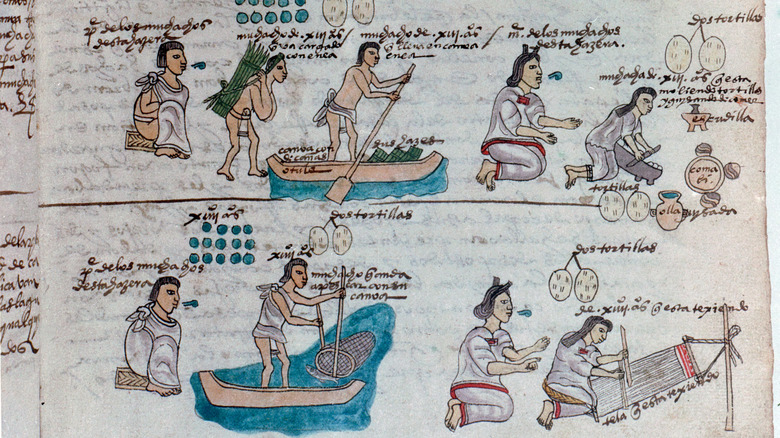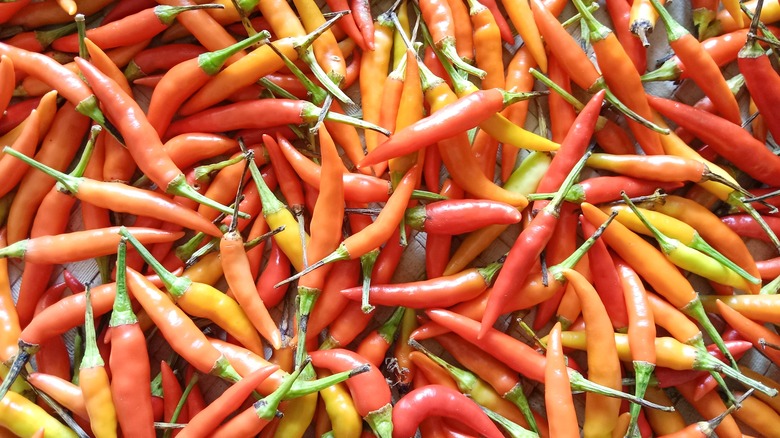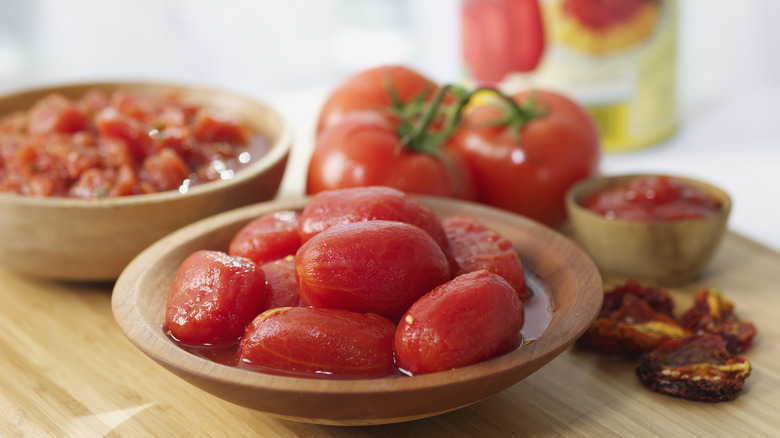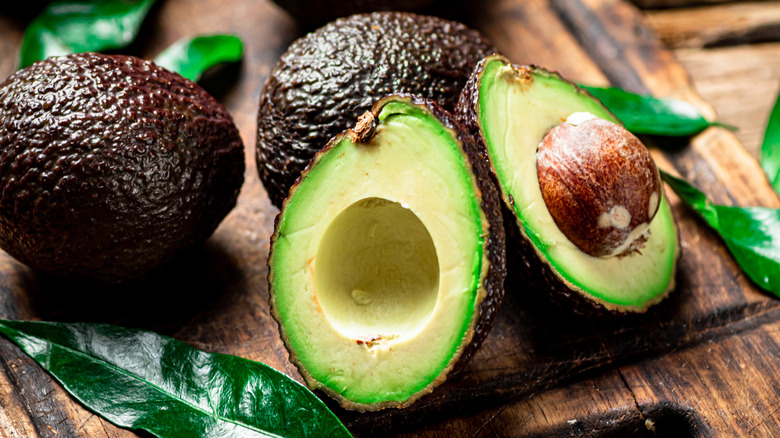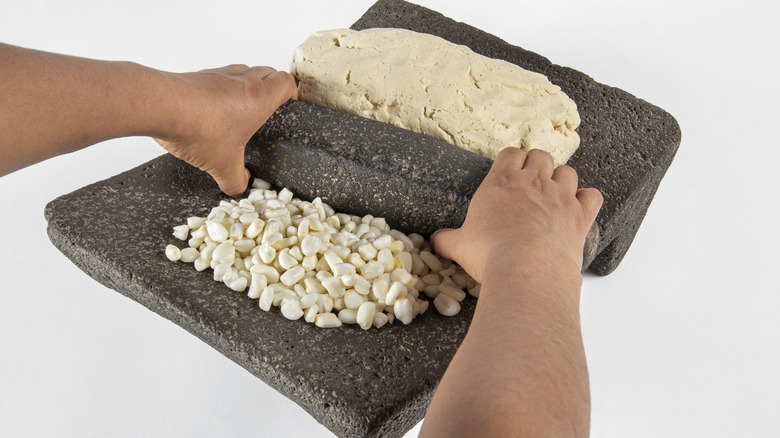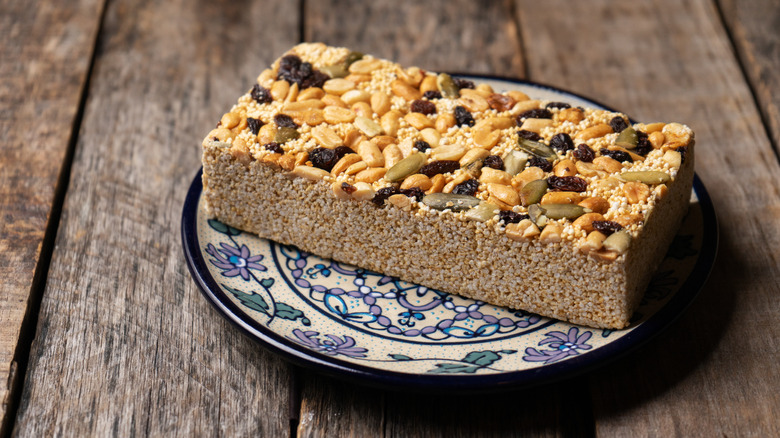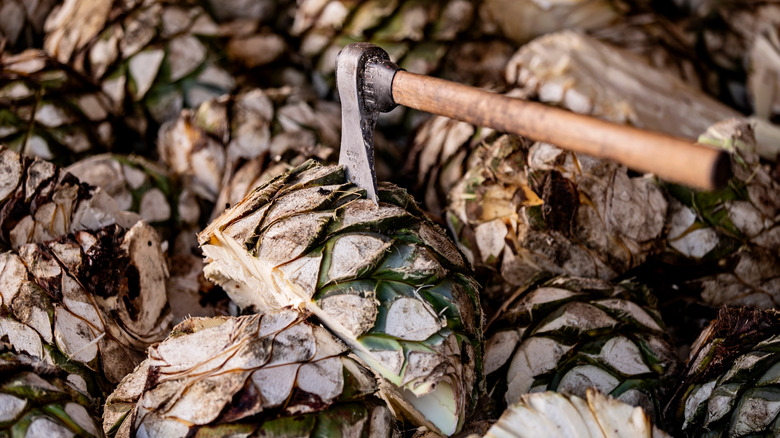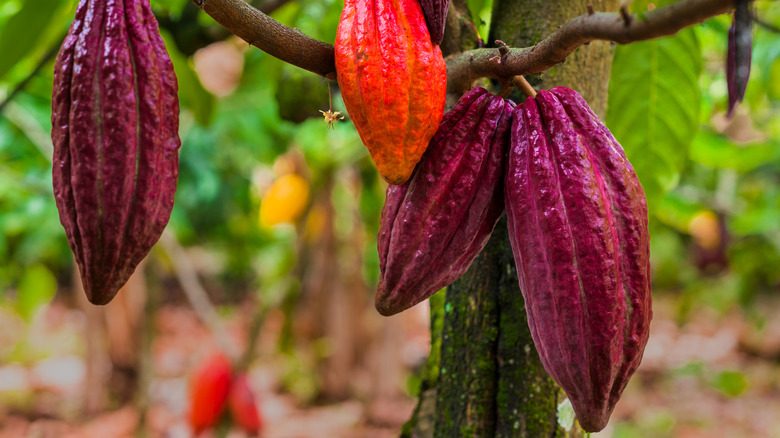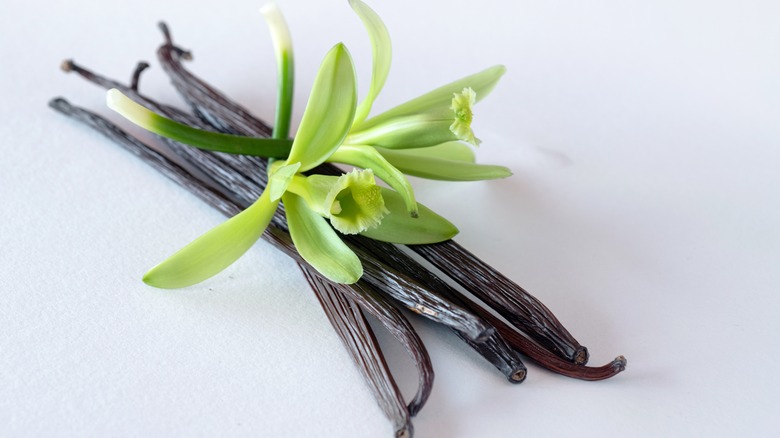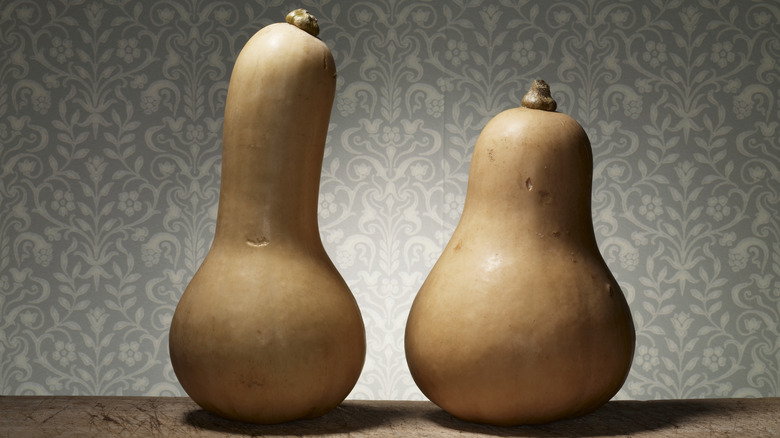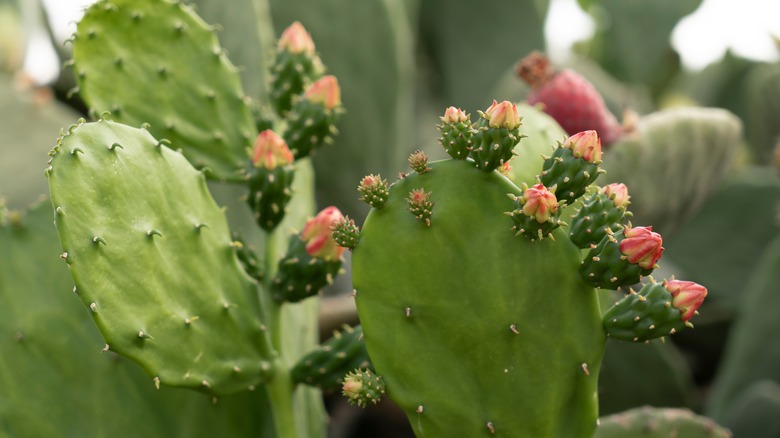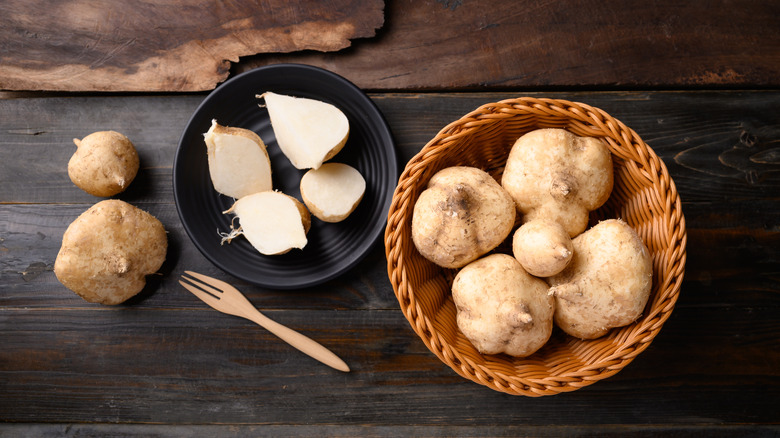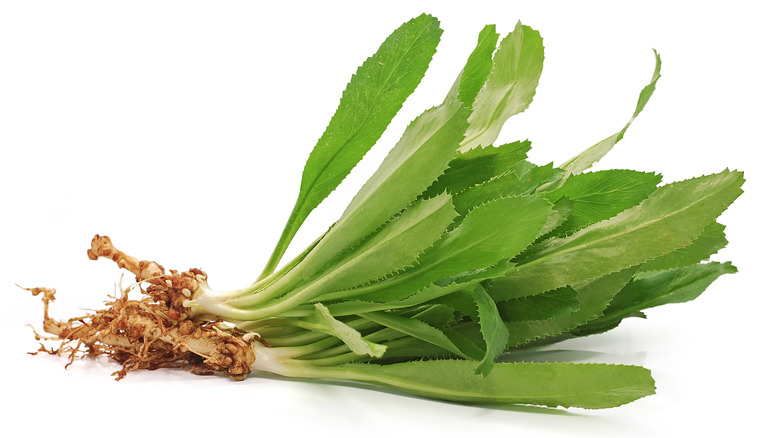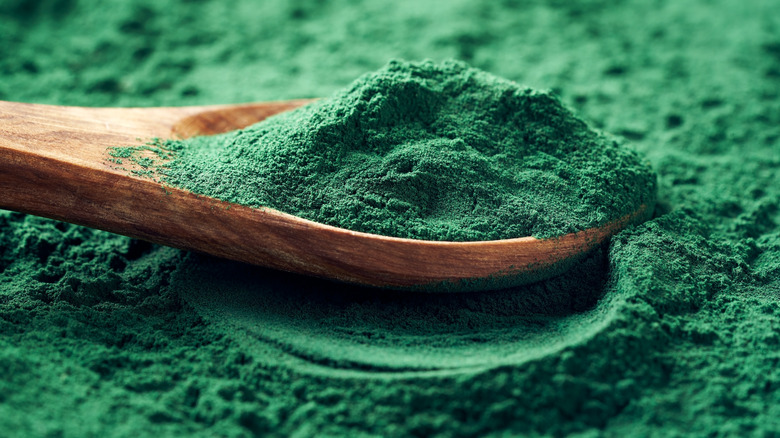15 Food Crops That Originated In Mexico
Can you imagine Indian food without chili peppers? What about Italian food without tomatoes? Today, these plants are essential to their respective cuisines, but they only became a part of those cuisines relatively recently, because both chilies and tomatoes are native to the Americas. Beginning in the late 15th century, European exploration and colonization led to the dispersal of American plants and animals around the world through trade, a phenomenon known as the "Columbian Exchange" because it began with the voyages of Christopher Columbus.
While South America gave us peanuts and potatoes, and the northern reaches of North America gave us blueberries, perhaps no place in the Americas has contributed more to global food culture than Mexico. There, Indigenous people like the Maya and Mexica (Aztecs) were the first to cultivate and consume food crops that have since become some of the most important in the modern world. Here are 15 food crops you might be surprised to learn originated in Mexico.
Chilies
In Mexico, archaeologists have found the earliest-known evidence of human consumption of chilis, dating back almost ten thousand years. It's unclear if these chilis were harvested from the wild or planted, but by the time Europeans arrived in the region in the early 16th century, chili cultivation was widespread, from Mexico to the lands of the Inca in South America. Indigenous farmers cultivated five species of chilis, diversified through selective breeding into as many as 40 different types of chilies that ranged widely in color, size, sweetness, and heat.
In the Indigenous cuisines of Mesoamerica, chili was second only to corn in its importance; in many societies, the day began with a bowl of cornmeal porridge spiced with chili powder. Chili is also featured in stews and the precursors of tamales, tacos, and ceviche. Mashed with stone tools similar to the modern Mexican molcajete, chili could be added to tomato salsa or to beverages like drinking chocolate and alcoholic pulque. Chili was also used in rituals and even as a punishment for misbehaving children, who might be forced to inhale burning chili smoke. Like several other crops on this list, the word "chili" comes from the plant's name in Nahuatl, the Aztec language. Europeans called these fruits "peppers" because their spicy bite reminded them of black pepper, which is native to Asia and not closely related.
Tomatoes
Tomato is another word that comes from Nahuatl via Spanish: the Aztecs called this plump, juicy fruit tomatl, from tomana, which means "swelling." The domestication date of tomatoes is uncertain, but they were especially valued in pre-Columbian cooking as a source of acidity since citrus fruits like lime are not native to the Americas. European accounts describe red, yellow, and green tomato varieties in many shapes and sizes, as well as the extra-sour tomatillo, a separate species. As fat and oil were not used in traditional Mesoamerican cooking, Indigenous cooks char-roasted tomatoes until soft on a bare, round griddle called a comalli, modern comal. They were then cooked in stews or mashed with chilies, salt, and other ingredients like herbs into salsa, similar to how they are still used in Mexico today.
Despite their widespread use in Mexico, tomatoes were once thought of as poisonous in Europe and took centuries to catch on there as a food rather than an ornamental plant. This is partly because tomato belongs to the family Solanaceae, which includes deadly nightshade, and partly because of European nobles who fell ill or even died after sampling dishes made with the fruit, thanks to an unfortunate chemical reaction. When tomatoes were served on the pewter plates used by the aristocracy, the acid caused lead to leech from the pewter. These mislabelled cases of lead poisoning resulted in the tomato earning the unfair nickname of "poison apple."
Avocado
There are still wild avocado species in Central America with tiny fruits, and archaeological evidence shows the avocados consumed by ancient people becoming larger over time, suggesting that farmers were breeding them selectively for fruit size. Avocado's importance in supporting human populations led Indigenous Mexicans to call it "the gift of the gods." Associated with virility and strength, the fruits were included in the tributes given to kings, and some Maya and Aztec cities used the avocado as their symbol. The Maya also planted avocados on or near the graves of the dead so that the spirit of their ancestors would return in the fruit.
One way avocado was originally prepared was mashed into a paste, likely with seasonings, though no exact recipe survives. This was known in Nahuatl as ahuacamolli, which simply means "avocado sauce;" you may recognize molli, the Nahuatl word for sauce, in the modern Mexican sauces known as mole. As the name transformed and additional ingredients not native to the Americas, such as lime and cilantro, were added, ahauacamolli became today's guacamole.
Corn
Maize was domesticated in Mexico as early as 9,000 years ago from an ancestral plant called teosinte and spread from there to other parts of the Americas. Just as other societies had their own staple grains, corn was the sacred staple for Mesoamerican Indigenous peoples. In many Mesoamerican traditions, human beings were said to be created from maize; the Maya even flattened the skulls of infants to produce an elongated head shape resembling an ear of corn. Corn was ground with a tool now called a metate and used to make cornflour porridge (atole) and numerous kinds of tortillas and tamales, which were eaten at every meal. Popcorn was also well-known, made into garlands and headdresses for festivals.
Before grinding, corn must be soaked and cooked in an alkaline solution, a process called nixtamalization, from the Nahuatl word for processed corn dough. Without this step, the niacin and other nutrients present in the corn cannot be absorbed by our bodies. Indigenous Americans nixtamalized their corn in a solution of water and wood ash or seashell ash in coastal areas. When corn was introduced as an alternative staple in Europe, populations who attempted to grow it suffered from pellagra, a disease caused by niacin deficiency until they learned how to process the grain.
Amaranth
Before the arrival of Europeans, up to 80% of the local diet in some Mesoamerican communities consisted of amaranth. It's easy to see why Indigenous Mesoamericans were so enamored with this plant: all parts are edible, including the tiny, round grains, which are rich in amino acids, iron, and protein, and are the only grain that contains Vitamin C. This wealth of nutrients was especially important given that the traditional Mesoamerican diet was mostly plant-based, with only elites consuming significant quantities of meat.
For one Aztec festival, puffed amaranth grain and honey were sculpted into a statue of Huitzilopochtli, patron god of the Aztec capital. This effigy was carried through the streets before being cut up and eaten by the celebrants. The Spanish were incensed by this practice's resemblance to the sharing of bread in the Christian Communion, so much so that they outlawed the growing of amaranth when they took control of Mexico. The plant continued to be cultivated in secret, and in Mexico today, amaranth candy is still consumed and still sculpted into shapes for holidays like the Day of the Dead. Modern puffed amaranth treats are often made with nuts and dry fruit and are known as alegría, Spanish for "joy."
Chia
The word chia can be traced to a Maya word meaning "strong." Although chia and amaranth are not closely related, the two plants have much in common. Both have very small seeds that pack a powerful nutritional punch, and both are often described in modern times as "superfoods." Both amaranth and chia were important Indigenous crops in 16th-century Mexico, and both were later outlawed by the Spanish colonial government because of their use in Indigenous religious rituals.
The tiny, crunchy seeds of chia, which belong to the same family as basil and mint, are rich in an array of nutrients, including protein, fiber, omega-3 fats, and calcium. In pre-Columbian Mesoamerica, chia seeds made ideal travel provisions because they were lightweight and nutritionally dense with a long shelf-life and were often carried by messengers, who had to travel long distances on foot in a society without horses. Chia seeds were commonly included in tributary offerings to kings and temples and were also used in medicine to treat leg pain and skin conditions.
Agave
A spiky, desert-dwelling species of agave called maguey was a valuable source of sugar for the Aztecs, who could not raise bees for honey in the climate of central Mexico as the Maya did in the tropical south. The procedure for harvesting sugar from agave was discovered sometime in the 10th century, according to Aztec accounts. If the flower stalk of the maguey is cut before it flowers, the heart of the plant can be tapped for a sugary liquid called aguamiel, Spanish for "honey water." This can be boiled down into maguey honey or fermented into alcoholic pulque, which is still produced in Mexico today.
The most famous Mexican spirits, mezcal and tequila are also produced from maguey, using juice pressed from the whole roasted heart of the plant rather than aguamiel. Distilled agave liquor didn't start to be produced in Mexico until the colonial era, when laborers arriving from another of Spain's colonies, the Philippines, brought with them techniques for making coconut liquor that were later applied to agave.
Cacao
In Mesoamerican religion, the reddish, oval-shaped pod of the cacao tree was associated with the human heart. Because the tree can only grow in a humid tropical climate, the Aztecs had to trade with their southern neighbors, the various Maya peoples, to acquire cacao beans. These were used in sacred religious rituals and noted for their unique effects on the body since cacao contains caffeine, a stimulant, as well as theobromine, which produces a mild relaxing effect. Cacao beans were so valued that they were used as currency. In the 16th-century markets of Tenochtitlan, a single cacao bean could buy you a tamal; one hundred could buy a turkey.
Fermented cacao beans were roasted, ground, mixed with water, and flavored with chili, vanilla, and other spices to produce a beverage which in Nahuatl was called xocolatl, "bitter water," the origin of the word "chocolate." This was a delicacy of the upper classes in Mesoamerican societies, who drank their chocolate frothy; different cultures preferred it hot or cold. Spanish aristocrats adopted the custom of drinking chocolate in the colonial era, initially as a breakfast drink similar in function to coffee. Chocolate eventually spread to all levels of European society but was not produced in solid form until the 19th century.
Vanilla
Like cacao, vanilla can only grow in a tropical rainforest environment, so it was cultivated by Indigenous peoples of southern Mexico, like the Maya and Totonacs. The Totonacs originally only grew vanilla for its scent, using the fragrant pods to perfume their homes and hair and for medicinal purposes, but it was later adopted as a spice. The Aztecs, who acquired vanilla through trade and tribute, included it in their chocolate beverage.
Vanilla is a flowering orchid vine that can only be pollinated in the wild by certain animals found in its native jungles. For this reason, vanilla could not be profitably grown outside of Mexico until 1841, when Edmond Albius, an enslaved 12-year-old boy living in the French colony of Réunion near Madagascar, invented a method for pollinating the flowers by hand. Almost all cultivated vanilla today is still pollinated by hand using Albius's method, and Madagascar has become especially known for its vanilla production.
Squash
Archaeological evidence suggests the domestication of squash in Mexico as early as 10,000 BC, making it one of humanity's oldest crops. Just as in Mexico today, ancient Mesoamericans consumed both the seeds and flesh of the squash and cooked it with chili and other vegetables. Squash was extra-valuable for early human societies because it had a variety of uses: the hard outer shells could be dried to make watertight storage containers, bowls, or musical instruments.
There are similar gourds native to Europe, Africa, and Asia, but most varieties called pumpkin or squash belong to one of four American species, all of which trace their origins to ancient Mexico. However, they were widespread throughout the Americas by the time Europeans arrived. Another edible species of squash now popular worldwide, the chayote or "vegetable pear," also originated in Mexico.
Sweet potato
Sugary, orange Ipomoea batata, the sweet potato, is often confused with potatoes and yams because of their similar roots, but it's only distantly related. Domestication of the sweet potato is believed to have occurred in southern Mexico, and the plant was being widely grown in northern South America and the Caribbean by 2500 BC. The tubers of sweet potatoes have a long shelf life, which makes them valuable for food storage and relatively easy to transport long distances, allowing them to be traded far and wide.
Historians still aren't certain when sweet potatoes arrived in the Pacific, but they have also been cultivated in places like Polynesia and New Guinea for centuries. The Columbian Exchange just continued the long tradition of spreading the sweet potato to new lands and populations: Columbus brought samples of the vegetable back to Spain from his first voyage to the Caribbean in 1492, and it was being grown in England by 1600.
Cactus
Many types of cactus are actually edible, especially their sweet, juicy fruits, and all of them originated in the Americas. One species of edible cactus native to Mexico is the dragonfruit; another is the prickly pear or nopal, which has been introduced to other arid, warm regions and can now be found growing wild in the Mediterranean. Nopal cactus has long held a special place in Mexican culture and cuisine. The Mexican flag features an eagle eating a snake on top of a nopal, a reference to the legendary sign from the gods that showed the Aztecs where to build their capital. The name of that city, Tenochtitlan, means "the place where prickly pears grow among the rocks."
The Aztecs cultivated cactus for food and also used their cactus orchards to farm the cochineal bug, an immobile insect that feeds on cactus juice and produces a brilliant red pigment, which saw widespread use before synthetic dyes became available. Cooking with nopales, the pads of the nopal cactus remain popular in Mexico today. Once you remove the spines, nopales can be grilled whole or cut into strips for vegetable tacos, stir-fries, soups, and pickles.
Jicama
Native to Mexico with a name derived from Nahuatl, like many other crops on this list, jicama is a member of the bean family. It grows as a vine and produces seedpods, like other beans, but these are toxic when mature, so the only part of the plant that's typically eaten is the bulbous root, which can weigh as much as 40 pounds. Jicama root has a crunchy white flesh and a mild flavor. Though usually eaten raw, it can be cooked and is also used as a source of starch.
There are two cultivated varieties of jicama, named for the clear and milky juice produced by their roots: jicama de agua (water) and jicama de leche (milk). Jicama de leche also has a more elongated root, while jicama de agua's root is rounder. Jicama de agua is the only one commercially marketed in the USA. Jicama is not cultivated outside of Mexico as widely as some of the other crops on this list, but it's been farmed in Southeast Asia since the colonial era when the Spanish brought it to the Philippines.
Culantro
The Columbian Exchange went both ways, with some crops and livestock being introduced to the Americas from Europe and becoming major elements of the local diet. One example is cilantro or coriander, which was only introduced to Mexico in the colonial era but has a long history in the cuisines of Asia and Europe. Pre-Columbian Indigenous people in Mexico and the Caribbean didn't know of cilantro, but they were familiar with one of its American relatives: culantro, also known as Mexican coriander, sawtooth coriander, or recao.
With its long, serrated leaves, culantro looks quite different from cilantro, but it has a similar smell and taste, though stronger and more pungent. In Indigenous Mesoamerican cuisine, it was likely used in the same ways that cilantro is used today and was also recognized for its medicinal properties, used to treat inflammation and gastrointestinal ailments. Culantro is also native to the Caribbean and remains important in the food of Puerto Rico and other Caribbean islands. In modern times the plant has also become a popular herb in Southeast Asia, where it thrives in a similar tropical climate.
Spirulina
The Aztecs had no large livestock before contact with Europeans, so they had to be creative when finding protein sources. One was spirulina, a blue-green alga harvested from the alkaline lakes in the central Valley of Mexico region that were the heartland of Aztec civilization. The Aztecs pressed spirulina into cakes, which were left to dry and age in the sun until crumbly and almost black. As the traditional Aztec diet also lacked dairy, some Spaniard observers called this aged algae "Aztec cheese." It was crumbled on top of other foods and used as a filling in tortillas and tamales.
Like chia, spirulina was valued by Aztec messengers as a nutrient-packed superfood for their long journeys; the algae is made of up to 60% protein and is also rich in iron, antioxidants, and various vitamins. Although its potential has long been overlooked, in recent years, spirulina is increasingly recognized for its nutritional value. As we enjoy our favorite modern foods, we should remember that we're eating a combination of ingredients drawn from all over the world and owe some of our favorites to Mexico and its Indigenous people.
